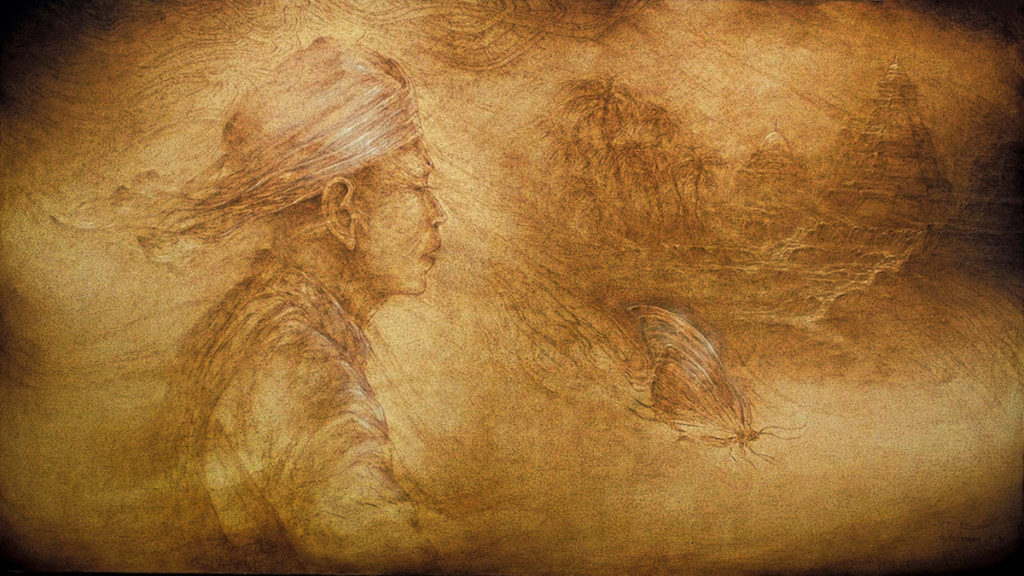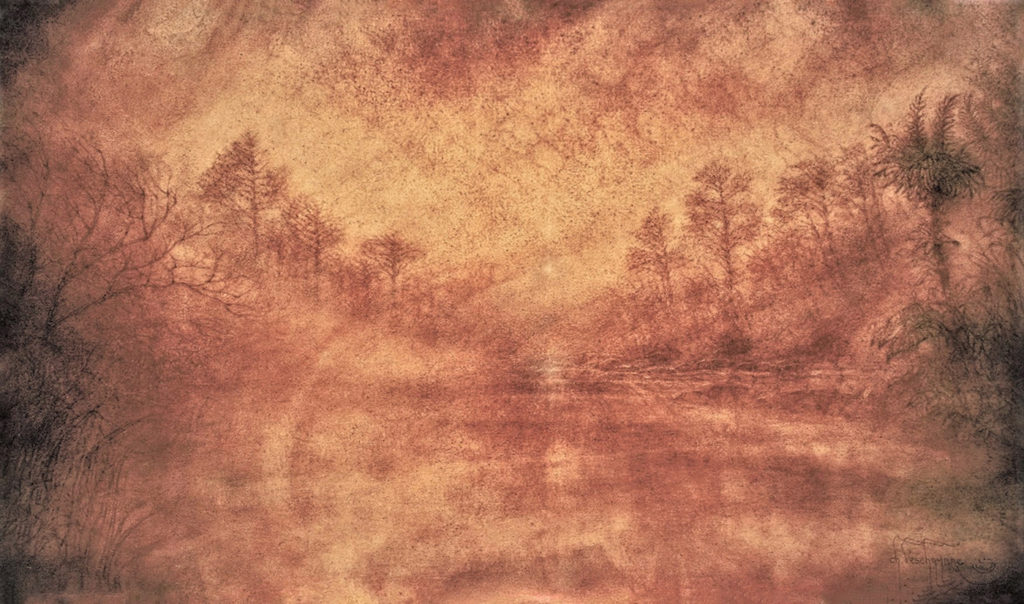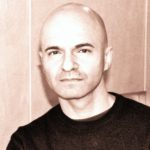
Dream Time: The Art of Christian Veschambre
all paintings are oil on canvas
Seeing a painting by Christian Veschambre for the first time can feel like you’ve been drawn into the vortex of an alternate universe. Figures emerge from a sandstorm unaware someone – us – is watching. They appear in profile or in movement, as if the force of the wind is sculpting them mid-action, sweeping away layers of stone and sand. We get the sense they’re not meant to be seen. When staring out from the canvas – as do some – they are as if startled, ready to frighten, protect, or to speak. Whoever they are, their presence seems to be hidden from the natural world. Until suddenly they materialize.
I first met Veschambre some years ago in the terre du bas of the Gallerie du Cheval de Sable in Paris’s Marais district. He was talking to a small group assembled around one tableau entitled, “Dream Time…Between Wind and Dust, Between Stars and Lights” (Le Temps du Rêve … Entre Vents et Poussières, Entre Etoiles et Lumières). In it, a monk, sage, or perhaps warrior, in profile with Asian features and closed eyes, faces a dream-like landscape where a step pyramid and a smattering of palms arise in a vision. An outsized butterfly emerges from the figure’s breath and swooshes towards the landscape as if to enter it. The paintings in this collection give the impression they were etched on antique pieces of parchment discovered in an archeological dig. Still others resemble jaundiced figurative sketches of an old master. Veschambre speaks to the group of a “vision of the world where beings float and vibrate in the light of an immaterial ocean.”
The idea of linear perspective in painting developed during the Renaissance takes new form in these canvases. Here, however, perspective concerns not so much distancing objects in a physical landscape as capturing the dynamic of presences oscillating between visible and invisible space through color gradients of mustard, red ochre, and earth. Seeing them immediately brought to my mind the writings of the philosopher and historian of religion Mircea Eliade who in his book The Sacred and the Profane, explores the spiritual understanding of space as lived by our ancestors. “For the religious man,” he writes, “space is not homogenous; it presents ruptures and breaks. There are parts of space that are qualitatively different from others.” It is this sense of space as ‘non-homogenous’ – lived as the opposition between sacred space (the only one that is real) and the amorphous (profane) space surrounding it – that inhabits Veschambre’s oeuvre.

If this were fiction writing, I would call these canvases forays into ‘world-building.’ This however, would imply a process of forging something out of nothing, and would be a misnomer, because Veschambre’s depictions are more like apparitions. He is seeing something that is already there. Opening up the breakages – or what Eliade calls ‘ruptures’ – in space that would otherwise escape our senses. These ruptures in space, Eliade says (counter to logic but intrinsic to religious thinking) are actually what allows for the creation of the world. They uncover the proverbial ‘still point’ – evoked in dervish mystical dances and observed in T.S. Eliot’s poem Burnt Norton, and many others – that opens the way to the only absolute reality, which is not the world of daily living but an alternate one that sustains it.
This ethereal perspective of reality may not appeal to all. So parallel to Veschambre’s aesthetic of the enigmatic, there is something else: the feeling of the unnatural, the ghostly, verging on the creepy, reminiscent of characters in Margaret Atwood’s stories who dissolve into or ‘become one’ with nature, as novelist and essayist Elvia Wilk describes in her recent book, Death by Landscape. Wilk offers a feminist understanding of the eerie and the weird in which “knowing how to dissolve and become other is a non-codified and embodied kind of knowledge that women, and other supposedly unstable bodies, have been cultivating for years.” The key word is ‘cultivating’ in the sense of planting, allowing the earth to take in and transform. It is a view that might appeal to more occultist or esoteric notions of the spiritual, or simply to the rest of us who live in a secularized and literal universe. But even here, in this space, Veschambre’s work remains versatile, depicting a world where landscape and humans mesh and become indistinguishable. Is the figure dissolving into sand, or is the sand amassing to form a figure? Does it make a difference?

In his book, The Weird and the Eerie, discussed by Wilk, author and critic Mark Fisher says the sensation of the eerie arises “either when there is something present where there should be nothing [failure of absence], or there is nothing present when there should be something [failure of presence].” Veschambre’s paintings simultaneously fulfill both these criteria. It is not clear whether the figures are appearing (failure of absence) or disappearing (failure of presence), making them doubly eerie. The sandstorm they inhabit acts like a mirage; we can never be sure what we are seeing. This is especially true of two of Veschambre’s paintings in which veiled figures, their backs to the viewer, again seem unaware of observers in their midst who – haphazardly – stumble upon them. They resemble, in that sense, the astonished characters in The Divine Comedy, as depicted by Gustave Doré, who ask how Dante and his guide were able to penetrate the netherworld. They are not meant to be there, as perhaps we are not meant to be here seeing this. It is in this eerie netherworld that Veschambre leads us where, expecting something, we find nothing, and where there is nothing we find something we’re uncertain should even be there.
When we speak, Veschambre is beyond reach, impenetrable, like an object in nature, a tree, a stone, perhaps even merged with them. I tell him I’d like to publish his work in an American literary journal. He agrees on the condition I forego trying to explain or comment on his method and approach and allow his work to speak for itself. Later, he wrote, saying, “words and discourse must never become the explanation, the argument, the justification of the work since they are only verbal packaging that seeks by default to substitute the work by giving it sense and substance.” Our conversation is short, but learning I’m from New York he says, as if to reassure me, that the native peoples of the Americas will one day prevail. I’m not sure why he tells me this and can’t help but find his assertion absurd if not delusional. Thinking of his paintings later, I realize they are an invitation to see reality differently, to explore its unseen workings which technological advancements have yet to undo. It is not so farfetched then to consider that ancient cultures and native peoples glimpsed this truth long ago and integrated it into their worldview. Veschambre’s paintings are a window into those unseen workings, where the material world dissolves, and we in it, where we encounter what mystics have named the awakening from the dream of reality. This is the vortex he opens in his paintings and we, like the figures in them, enter unaware.
– John P. Apruzzese
Translation Editor, LIT
* * *
prose poems by Christian Veschambre
Light of Immaterial Ocean
Shimmer, vision of a world where beings float and vibrate in the light of an immaterial ocean…
transience of matter, interpenetration of bodies and cosmic energies.
Matter becomes spirit, spirit matter…between wind and dust, stars and light…
The way of man, the trail of the gods. Fleeting presence, eternal moment…
Time halts, the present dissolves into timelessness…the world is so far away now and yet so close,
so intimate with the essence of who we are…the sense of infinity and eternity is all that remains in us;
Maybe it’s what the Australian Aborigines call “Dream time,” nostalgia, dreamlike memory of the Garden of Eden,
of a lost paradise where humanity and nature lived in harmony and peace.
Seeing beyond one’s own existence…thousands, millions of years contemplate us, are reflected in our dreams,
our memories, our consciousness…illuminating our starlit path.
Or as Albrecht Dürer said at the end of his life:
“I’m beginning to see Nature in its original beauty and understand that the supreme expression of art is simplicity

Lumière d’un Océan immatériel
Reflet, vision d’un monde où les Êtres flottent et vibrent dans la Lumière d’un Océan immatériel…
Impermanence de la matière, interpénétration des corps et des énergies cosmiques.
La Matière se spiritualise, l’Esprit se matérialise…Entre Vents et poussières, entre étoiles et Lumières…
Le chemin des Hommes, le sillage des Dieux. Présence éphémère, instant d’éternité…
Le Temps s’arrête, le Présent se dilue dans l’intemporalité…Le Monde maintenant si lointain et pourtant si proche,
si intime à l’Essence même de ce que nous sommes…Seule subsiste en l’Homme cette parcelle d’Infini et d’Éternité ;
Peut-être ce que les Aborigènes d’Australie appellent « Le temps du rêve », nostalgie, souvenir onirique du Jardin d’Éden,
D’un paradis perdu où l’Homme et la Nature vivaient en Harmonie et en Paix.
Voir par-delà sa propre existence…Les milliers, les millions d’Années nous contemplent, se reflètent dans nos Rêves,
nos Mémoires, nos Consciences…Éclairant notre chemin de la Lumière des Etoiles.
J’aimerais enfin citer cette réflexion d’Albrecht Durer à la fin de sa vie :
« Je commence à considérer la Nature dans sa pureté originelle et à comprendre que l’expression Suprême de l’art est la
simplicité ».
* * *

Are we not supposed to evolve, in a Darwinian sense, through the way of the spirit?
– Christian Veschambre

L’ Homme ne doit-il pas évoluer, au sens darwinien du terme, par la Voie de l’Esprit…?
– Christian Veschambre

Ferryman
Are we not supposed to evolve, in a Darwinian sense, through the way of the spirit?
The artistic work being one of those ways…a natural predisposition, innate, inherent in our spiritual nature, to
be able to enrich… transcend and elevate our level of consciousness…above…to try to go beyond the
commonplace, the unstable, the uncertain in the human condition…this ability, this gift to sanctify the
profane…sublimate it, dream it…this ability to be able to lift ourselves above it, to break free, to be released
by way of the spirit…to enter another dimension…and move beyond and experience verticality…

Le Passeur
L’Homme ne doit-il pas évoluer, au sens darwinien du terme, par la Voie de l’Esprit … ?
L’œuvre artistique étant une de ses Voies … une prédisposition naturelle, innée, immanente à
sa nature spirituelle, à pouvoir se bonifier … se transcender et élever son niveau de conscience
… au-dessus … pour tenter de dépasser la platitude, la précarité, l’incertitude de la condition
humaine … cette aptitude, ce don pour sacraliser le profane … le sublimer, le rêver … cette
aptitude aussi à pouvoir ainsi s’en extraire, s’en affranchir, s’en libérer par la Voie de l’Esprit …
Se projeter dans une autre dimension … l’expérience du dépassement par la verticalité …
* * *

The beauty of the artistic work, a ferryman who takes us, transports us,
guides us, towards other shores, other countries…to awaken us and reveal…
from one shore to the other…from one state of consciousness to the other…
Always further? Always higher?…Always closer to who we are….
following the arc of a life’s journey? A journey that follows an elliptic arc,
like a vast circle?…Like the time it takes for a planet to revolve?
The same voyage, each year and for millions of years, of the earth around the sun.

La Beauté de l’œuvre artistique, un Passeur pour nous emmener, pour nous transporter,
pour nous guider, vers d’autres Rivages, d’autres Contrées … nous éveiller, nous révéler …
d’une rive à l’Autre … d’un monde à l’Autre … d’un état de conscience à I’Autre …
Toujours plus Loin ? Toujours plus Haut ? … Toujours plus Près de ce que nous Sommes
A l’image de ce qu’est la trajectoire d’un Chemin de Vie ? Une Voie à trajectoire elliptique,
comme une grande boucle ? … Comme l’est une période de révolution en astronomie ?
Le même voyage, chaque année et depuis des milliards d’années … de la Terre autour du Soleil
* * *
When the deep breath of the earth
Permeates the forgotten shores of our consciousness…
– Christian Veschambre

Quand le Souffle profond de la Terre
Imprègne les Rivages oubliés de nos Consciences …
– Christian Veschambre
* * * * * * * * *

Christian Veschambre is a French visual artist, painter, and poet who lives in Paris, France. He is a graduate of the Ecole Nationale Supérieur des Beaux Arts de Paris. He has exhibited widely in France and in Europe and his work has received numerous awards and distinctions.
Cover artwork: “Le Souffle” (76 x 46 cm).




